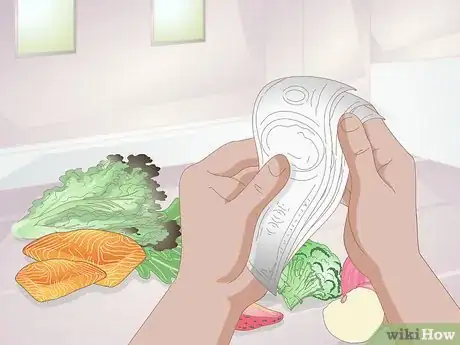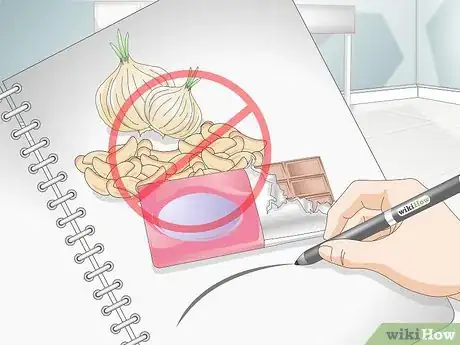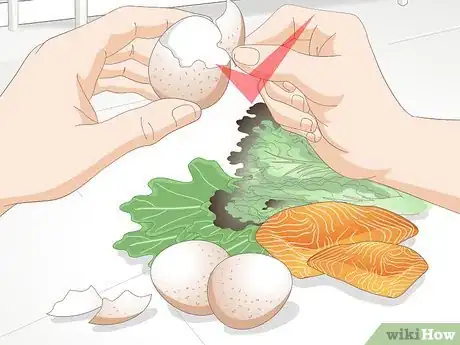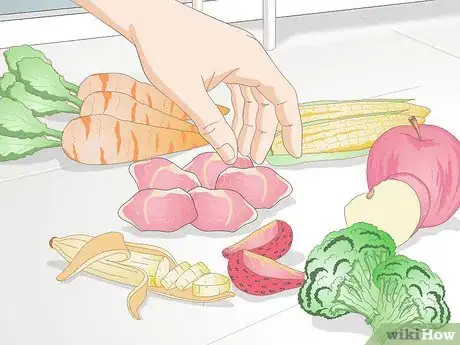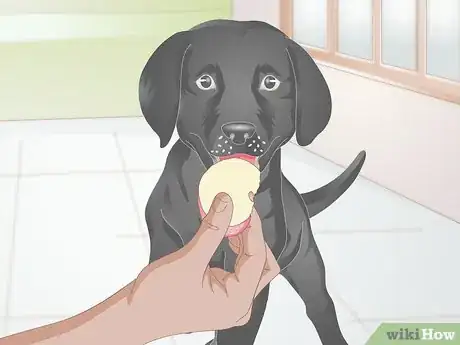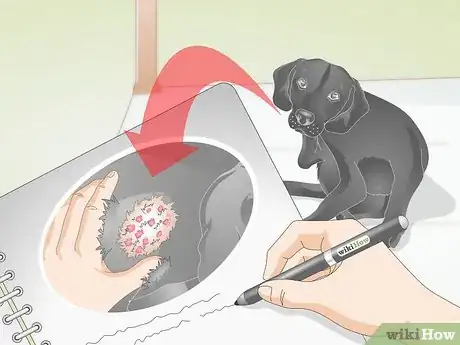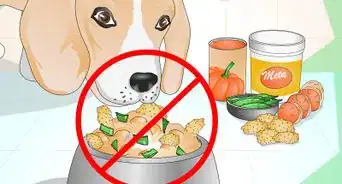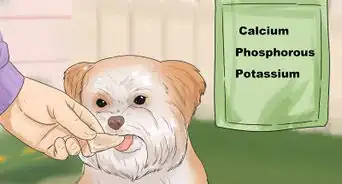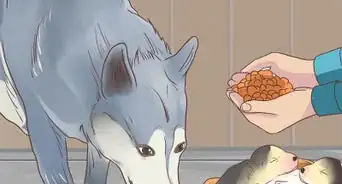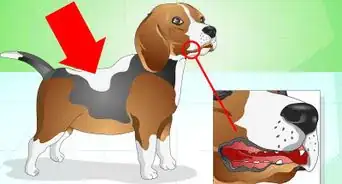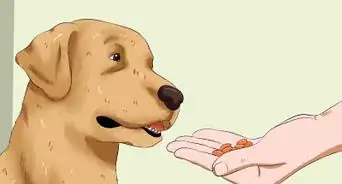This article was co-authored by Brian Bourquin, DVM. Brian Bourquin, better known as “Dr. B” to his clients, is a Veterinarian and the Owner of Boston Veterinary Clinic, a pet health care and veterinary clinic with three locations, South End/Bay Village, the Seaport, and Brookline, Massachusetts. Boston Veterinary Clinic specializes in primary veterinary care, including wellness and preventative care, sick and emergency care, soft-tissue surgery, dentistry. The clinic also provides specialty services in behavior, nutrition, and alternative pain management therapies using acupuncture, and therapeutic laser treatments. Boston Veterinary Clinic is an AAHA (American Animal Hospital Association) accredited hospital and Boston’s first Fear Free Certified Clinic. Brian has over 19 years of veterinary experience and earned his Doctor of Veterinary Medicine from Cornell University.
There are 8 references cited in this article, which can be found at the bottom of the page.
This article has been viewed 27,757 times.
Feeding your dog whole food is a healthy move from a commercial dog food diet containing a host of artificial preservatives, additives, and by-products. Discuss the change with your veterinarian, make sure it suits your budget, and inform yourself about what foods are harmful to dogs. Introduce whole foods slowly, be cautious about raw foods, and make sure that your dog is fed what it is meant to consume by nature (i.e. meat.) Feed your dog fruits and vegetables as snacks and try making your own dog treats. Monitor your dog’s health during the first few weeks of its new diet to make sure it stays healthy and happy.[1]
Steps
Getting Informed About Whole Food Diets
-
1Talk to a veterinarian. Before feeding your dog whole foods, get more information about your dog's nutritional needs. Consult your veterinarian for advice on what your dog should be consuming on a day-to-day basis, and in what portions.[2] In addition, ask for advice on how to monitor your dog's health after changing its diet (e.g. keeping an eye out for gastrointestinal upsets or skin irritations). [3]
- Ask your vet if your dog should be given vitamins or supplements with their whole food diet; do not purchase such products without a specific recommendation.
-
2Plan your budget for a whole food diet. Before embarking on a whole food diet for your pet, make sure that you can afford to feed your dog quality ingredients. Make a week-long sample menu for your dog (including treats and snacks) and calculate the approximate costs. Compare this amount to what you are currently spending on commercial dog food and treats, and ensure that you will have the extra money (if it works out to more) to keep up with a whole food diet.
- Feeding your dog whole foods doesn’t not have to mean a complete overhaul of its diet - if a whole food diet seems too costly for you or your family to afford, consider adding small amounts of whole food to your dog’s diet to supplement its regular dog food.
Advertisement -
3Make a list of "NEVER" foods. While feeding your dog whole foods can be very beneficial for its health, there are a number of foods that could be toxic to your pet if consumed. Inform yourself by speaking to your veterinarian or researching these foods on reliable websites like petMD. Write a clear list and post it on the fridge or wall for other members of your family to keep in mind. Some notable foods to keep away from your dog are:[4]
- Chocolate (especially dark chocolate), which can cause vomiting, diarrhea and seizures.
- Onions and garlic, which can cause the destruction of red blood cells and lead to anemia when consumed in large quantities, or over a long period of time
- Alcohol, which can be life-threatening even in small amounts.
- Yeast dough (notably the store bought kind that is used in making bread, rolls, and pizza), which can create alcohol in a dog's stomach and be potentially deadly.
- Grapes and raisins, which can cause kidney failure.
- Artificial sweeteners like xylitol, which can be incredibly toxic.
Introducing the New Diet
-
1Introduce whole foods slowly. Start introducing whole foods to your dog’s diet by adding portions to its regular kibble. Be sure to reduce the amount of dog food your portion out to accommodate the whole foods that you’re adding. To start, or as a regular addition to a regular kibble diet, new ingredients should make up about 25% of your dog’s meals, and can include:[5]
- Eggs (raw or cooked), which provide high quality protein and fat
- Canned fish (e.g. sardines or pink salmon), supplying omega-3 fatty acids that are good for your dog’s skin and coat, and which help regulate the immune system and reduce inflammation
- Leafy greens, which can allow you to increase the amount you feed your dog without increasing their calorie intake significantly
- Healthy leftovers (e.g. meat offcuts), preferably in small quantities to prevent weight gain
-
2Maintain an omnivorous diet. While dogs’ teeth and digestive tracts show carnivorous traits, dogs also have the proven ability to digest carbohydrate-based foods. There is, however, a carnivorous bias that makes meat an integral part of the canine diet; whatever your personal choices may be, never force a vegan or vegetarian diet onto a pet that’s body is optimized to consume meat. Give your dog a balanced diet of meat, grain, and fruits and vegetables to provide optimal health without turning away from its ancestral diet.[6]
-
3Be cautious about “raw food diets”. Raw food diets, or B.A.R.F. diets (Biologically Appropriate Raw Food diets), have grown in popularity and aim to mimic what dogs would eat in the wild (i.e. raw meats, grains, vegetables, and bones.) There is no definite evidence that this sort of diet is more beneficial for dogs than other diets, but there are a number of health risks associated with it, including exposure to dangerous bacteria and injury from bones. While dogs’ digestive tracts can process raw meat, the presence of bacteria can still pose the threat of gastrointestinal distress and illness for both a dog and its owners. If you pursue a raw food diet for your dog, play it safe by:[7]
- Following the U.S. Department of Health guidelines for food preparation and safety (visit https://www.foodsafety.gov/)
- Removing small or splintered bones from your dog’s food
- Making sure that you and your family are all diligent about maintaining a clean food preparation space
-
4Give your dog fruits and vegetables as snacks. Outside of your dog’s regular meals, snacks can be a great way to add whole foods to its diet. Feed fruits and vegetables (raw or cooked) to your dog as snacks, keeping in mind those that fall onto the “never” foods list (e.g. grapes). Feel free to let your dog snack on:
- Green beans, as they contain omega-3 fatty acids, vitamins A, C, and K, calcium, copper, fiber, folic acid, iron, niacin, manganese, potassium, riboflavin, thiamin, and beta carotene
- Spinach, which is high in iron and helps fend off inflammatory and cardiovascular issues
- Apples, which are high in vitamin C and antioxidants
- Watermelon, a good source of vitamin A, B-6 and C, and thiamin
- Pumpkin, a food high in fiber, vitamin A and anti-oxidants, which can also alleviate diarrhea and constipation
-
5Make homemade dog treats. Making your own dog treats is not only a healthy choice for your dog (free of preservatives and byproducts), it can also save you money. You also have the option of sneaking beneficial ingredients into your treats, such as fish oil to improve your dog’s coat; other healthy ingredients to include in treats may include peanut butter, oatmeal, honey, bananas, and berries. While most homemade dog treats will generally last about a week, you can also freeze them to keep on hand for your pet.[8]
- For example, try making your own jerky treats as an alternative to store-bought raw hides – cut chicken or sweet potatoes into 1/8 inch strips and bake at 200 degrees F for 2 hours.
-
6Monitor changes in your dog. During the initial period when you introduce whole foods into your dog’s diet, take note of the changes in its health and mood. For a detailed account of changes, keep a journal where you write down exactly what you are feeding your dog, and the notable differences in its health (for example, an increase in energy, or a shinier coat.) Tracking your dog’s diet on paper is a reliable way to identify possible food allergies; symptoms of food allergies may include:
- Recurrent ear problems
- Itchy skin that doesn’t respond to steroid treatments
- Skin problems that occur all year round, regardless of season or climate
- Hair loss
Expert Q&A
-
QuestionWhat can you feed your dog if you run out of food?
 Pippa Elliott, MRCVSDr. Elliott, BVMS, MRCVS is a veterinarian with over 30 years of experience in veterinary surgery and companion animal practice. She graduated from the University of Glasgow in 1987 with a degree in veterinary medicine and surgery. She has worked at the same animal clinic in her hometown for over 20 years.
Pippa Elliott, MRCVSDr. Elliott, BVMS, MRCVS is a veterinarian with over 30 years of experience in veterinary surgery and companion animal practice. She graduated from the University of Glasgow in 1987 with a degree in veterinary medicine and surgery. She has worked at the same animal clinic in her hometown for over 20 years.
Veterinarian In the short term, any bland human food such as chicken or white fish with rice or pasta is just fine. This will tide the dog over until you can get to the store, but isn't nutritionally balanced for long term feeding.
In the short term, any bland human food such as chicken or white fish with rice or pasta is just fine. This will tide the dog over until you can get to the store, but isn't nutritionally balanced for long term feeding. -
QuestionHow much home cooked food should I feed my dog?
 Pippa Elliott, MRCVSDr. Elliott, BVMS, MRCVS is a veterinarian with over 30 years of experience in veterinary surgery and companion animal practice. She graduated from the University of Glasgow in 1987 with a degree in veterinary medicine and surgery. She has worked at the same animal clinic in her hometown for over 20 years.
Pippa Elliott, MRCVSDr. Elliott, BVMS, MRCVS is a veterinarian with over 30 years of experience in veterinary surgery and companion animal practice. She graduated from the University of Glasgow in 1987 with a degree in veterinary medicine and surgery. She has worked at the same animal clinic in her hometown for over 20 years.
Veterinarian This question highlights one of the problems of feeding home prepared foods. Each food contains a different number of calories, so you need to feed different amounts depending on the individual recipe. There's no one-size-fits-all answer.
This question highlights one of the problems of feeding home prepared foods. Each food contains a different number of calories, so you need to feed different amounts depending on the individual recipe. There's no one-size-fits-all answer. -
QuestionIs it OK to feed your dog human food?
 Pippa Elliott, MRCVSDr. Elliott, BVMS, MRCVS is a veterinarian with over 30 years of experience in veterinary surgery and companion animal practice. She graduated from the University of Glasgow in 1987 with a degree in veterinary medicine and surgery. She has worked at the same animal clinic in her hometown for over 20 years.
Pippa Elliott, MRCVSDr. Elliott, BVMS, MRCVS is a veterinarian with over 30 years of experience in veterinary surgery and companion animal practice. She graduated from the University of Glasgow in 1987 with a degree in veterinary medicine and surgery. She has worked at the same animal clinic in her hometown for over 20 years.
Veterinarian Dogs can eat a wide variety of human foods, but the trick is to make sure the diet is balanced in the long term. Many owners feed a deficient diet without realizing it, which can be bad for their pet in the long term. To feed a healthy well-balanced doggy diet, speak a veterinary nutritionist who can create a custom menu for your dog.
Dogs can eat a wide variety of human foods, but the trick is to make sure the diet is balanced in the long term. Many owners feed a deficient diet without realizing it, which can be bad for their pet in the long term. To feed a healthy well-balanced doggy diet, speak a veterinary nutritionist who can create a custom menu for your dog.
References
- ↑ https://www.happydogfood.com/pages/benefits-of-whole-foods
- ↑ Brian Bourquin, DVM. Veterinarian. Expert Interview. 20 December 2019.
- ↑ https://www.petfinder.com/dogs/dog-nutrition/home-cooked-dog-food-diets/
- ↑ http://www.petmd.com/dog/centers/nutrition/slideshows/toxic-foods-for-dogs
- ↑ http://www.whole-dog-journal.com/issues/14_5/features/Improving-Your-Dogs-Diet_20260-1.html
- ↑ https://www.dogfoodadvisor.com/canine-nutrition/dogs-carnivores-omnivores/
- ↑ https://vet.osu.edu/vmc/companion/our-services/nutrition-support-service/myths-and-misconceptions-surrounding-pet-foods
- ↑ http://www.moneycrashers.com/homemade-dog-food-treat-recipes/
About This Article
Before you feed your dog whole foods, talk to your vet to make sure it will be a healthy choice for your pup. Once your vet has approved the new diet, start introducing the whole foods slowly so you don’t upset your dog’s stomach. To do this, add small portions of the whole foods to your dog’s kibble and gradually increase the amount over time. You can try feeding it eggs, canned fish, leafy greens, and healthy leftovers like meat offcuts, which will give your dog plenty of nutrients. While you can feed your dog non meat items, keep in mind that meat is necessary for your dog to stay healthy, so don’t try forcing a vegan or vegetarian-only diet. To learn how to make your own whole food dog treats, read more from our Veterinary co-author!


